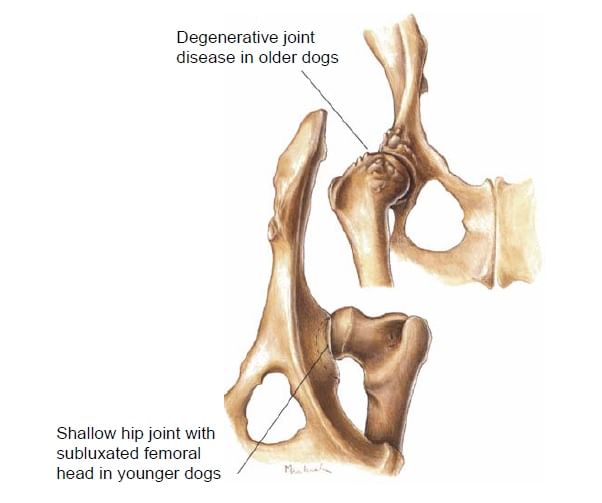Get the App
For Doctors
Login/Sign-up
WHAT IS CANINE HIP DYSPLASIA?
Canine hip dysplasia is the abnormal development and growth of a dog's hip joint. It occurs commonly in large breed dogs such as Labrador retrievers, German Shepherds, Rottweilers, and Saint Bernards, but it can occur in dogs of any breed and size, and even in cats. There is no single cause of hip dysplasia; rather it is caused by multiple factors, some of which include genetics and nutrition. The abnormal development of the hip joint that occurs in young dogs with dysplasia leads to excessive hip joint laxity (looseness). This laxity causes stretching of the supporting ligaments, joint capsule, and muscles around the hip joint, leading to joint instability, pain, and permanent damage to the anatomy of the affected hip joint. If left untreated, dogs with hip dysplasia usually develop osteoarthritis (degenerative joint disease).
Dogs with hip dysplasia commonly show clinical signs of hind limb lameness, pain, and muscle wasting (atrophy). Owners report that their dogs are lame after exercise, run with a "bunny-hopping" gait, are reluctant to rise or jump, or aren't as active as other puppies. Many dysplastic dogs will show these signs early in life (6-12 months of age), but some dogs do not show signs of pain until they are older.
Diagnosis: Examination by touch and confirmation by radiographs.
Treatment and care: Conservative treatment benefits many patients when they experience signs of hip dysplasia. This treatment includes enforced rest, anti-inflammatory drugs and pain medication. Once the clinical signs are controlled, the therapy includes weight reduction if needed and an exercise program designed to improve the strength of your pet’s rear legs. Such an exercise program might include swimming and walking uphill. Surgical treatment being more invasive, is not practiced regularly, and does not preclude the need of conservative therapy.
The signs may aggravate during the season transition and patients may need support of pain medications during such period.
Nutrition: For younger patients – food that supports development and tissue repair may be offered. Optimal nutrition is also targeted to reduce health risks associated with excessive calcium and phosphorus (which may cause skeletal problems), and excess calories (which may cause obesity). Dietary therapy for dogs with hip dysplasia includes a diet that will help dogs run better, play better and rise more easily while maintaining optimal body weight. A joint diet should have added EPA (eicosapentanoic acid) an omega-3 fatty acid that has been shown to help maintain joint function, enhanced levels of glucosamine and chondroitin to provide the building blocks of healthy cartilage
and L-carnitine to maintain optimal weight.
Pets with hip dysplasia should not be mated/bred, as they can potentially transmit the “Defective Gene” to their progeny!
Canine hip dysplasia is the abnormal development and growth of a dog's hip joint. It occurs commonly in large breed dogs such as Labrador retrievers, German Shepherds, Rottweilers, and Saint Bernards, but it can occur in dogs of any breed and size, and even in cats. There is no single cause of hip dysplasia; rather it is caused by multiple factors, some of which include genetics and nutrition. The abnormal development of the hip joint that occurs in young dogs with dysplasia leads to excessive hip joint laxity (looseness). This laxity causes stretching of the supporting ligaments, joint capsule, and muscles around the hip joint, leading to joint instability, pain, and permanent damage to the anatomy of the affected hip joint. If left untreated, dogs with hip dysplasia usually develop osteoarthritis (degenerative joint disease).
Dogs with hip dysplasia commonly show clinical signs of hind limb lameness, pain, and muscle wasting (atrophy). Owners report that their dogs are lame after exercise, run with a "bunny-hopping" gait, are reluctant to rise or jump, or aren't as active as other puppies. Many dysplastic dogs will show these signs early in life (6-12 months of age), but some dogs do not show signs of pain until they are older.
Diagnosis: Examination by touch and confirmation by radiographs.
Treatment and care: Conservative treatment benefits many patients when they experience signs of hip dysplasia. This treatment includes enforced rest, anti-inflammatory drugs and pain medication. Once the clinical signs are controlled, the therapy includes weight reduction if needed and an exercise program designed to improve the strength of your pet’s rear legs. Such an exercise program might include swimming and walking uphill. Surgical treatment being more invasive, is not practiced regularly, and does not preclude the need of conservative therapy.
The signs may aggravate during the season transition and patients may need support of pain medications during such period.
Nutrition: For younger patients – food that supports development and tissue repair may be offered. Optimal nutrition is also targeted to reduce health risks associated with excessive calcium and phosphorus (which may cause skeletal problems), and excess calories (which may cause obesity). Dietary therapy for dogs with hip dysplasia includes a diet that will help dogs run better, play better and rise more easily while maintaining optimal body weight. A joint diet should have added EPA (eicosapentanoic acid) an omega-3 fatty acid that has been shown to help maintain joint function, enhanced levels of glucosamine and chondroitin to provide the building blocks of healthy cartilage
and L-carnitine to maintain optimal weight.
Pets with hip dysplasia should not be mated/bred, as they can potentially transmit the “Defective Gene” to their progeny!


+1.svg)
